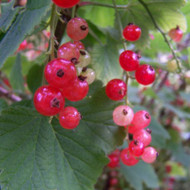Dense shade. For most of us, the part of the garden that gets very little sunlight during the day is one of the trickiest areas to manage successfully. The ornamental gardener is almost spoilt for choice with a rich tapestry of ferns, hostas and woodland bulbs to create year-round interest. For the fruit gardener, it is much more problematic – we are always striving to grow the sweetest, most delicious produce and it is sunlight which forms the sugars in the fruit. So let’s look at one of the very best plants for growing in just such inauspicious conditions – the redcurrant.
The red currant (Ribes rubrum) is a member of the Ribes genus in the gooseberry family. It is considered a native plant through much of Northern Europe. There are several other closely related species, native across other parts of the globe, but the red currant that we know has been cultivated in gardens for several hundred years. It’s thought that large berried cultivars were first selected in Belgium and North East France in the 1600’s. The French town of Bar-le-Duc has a long history of making a fine red currant jelly, highly prized by foodies to this day. The currants are picked by hand and the pips removed using a goose feather - very intricate and labour intensive work, which no doubt contributes to the high price of these little jars of heaven. Plant your own bush and you can enjoy making this fine accompaniment to lamb or turkey - using a goose feather is entirely optional! Whitecurrants are exactly the same species, botanically, but they are a naturally occurring albino variant (lacking in pigment, so the currants are an exquisite translucent ivory colour). Whitecurrants are also generally slightly sweeter, so are an excellent choice for eating fresh.
Redcurrants are extremely tolerant of shade - they will happily grow and crop even on a north wall where they receive no direct sunlight. They will happily grow in almost all soils, although for preference they do slightly better in a soil that doesn’t dry out in the summer. In Southern England you can occasionally come across clumps of wild redcurrants that have escaped from gardens and they are generally growing in amongst groves of alders in damp woodland. Recreate these conditions- shade and moisture - and your redcurrants will thrive.
The traditional time for planting is during the winter months, when nurseries will offer bare root bushes. These days you will be able to find pot grown plants at a garden centre all year round, although the choice of variety will be smaller. As ever, take extra care if planting during the hot summer months and keep well-watered until established. Redcurrants will grow to a reasonable size, so allow 1.2m per plant if growing as a traditional bush. Prepare a generous planting hole, incorporating plenty of organic matter to improve soil structure and moisture retention. Redcurrants, like their close relative the gooseberry, respond well to mulching in early Spring to seal in moisture. In most soils they will not need extra feeding, although if you have some tomato feed to hand they will enjoy a little if applied when the flowers are forming in April.
Redcurrants fruit on old wood, so although they are normally grown as freestanding small bushes, they are very amenable to being trained as single cordons or fans against a wall or fence. Pruning is very straightforward- once they have finished fruiting in late summer, just prune back any unwanted growth. Start by clearing out the centre to allow better air circulation (think of a wine goblet and you won’t go far wrong) and the cut back any new growth by about half to keep the plant in check. If training as a cordon, shorten any side shoots to 6cm or so. The old wood stays productive for years, so it’s more about shaping the plant to suit the space than any particular need to increase yields.
As with many soft fruits, the main pests are birds. They are very partial to redcurrants, so net plants to protect your crop so it can ripen fully otherwise it will disappear before you get a chance to enjoy any yourself. Otherwise red and whitecurrants are some of the easiest and most trouble free of all fruit crops. Young foliage in Spring can be attacked by aphids - you’ll notice the distinctive blisters as the leaves pucker and curl - but it never overly affects crops. Use a soft soap solution, or blast the foliage with a jet of water from your garden hose, and you’ll prevent the worst of the damage. The damaged foliage will be removed by the late summer prune.
Redcurrant varieties:
Junifer. Probably the earliest cropping variety, you can harvest long sprigs of full bright red berries from the end of June onwards. Crops heavily on young and old wood, so quick into production. An excellent recent introduction which is bound to become a firm favourite.
Rotet. Another late season variety, very heavy cropping.
Rosetta. One of the latest varieties to flower and crop, so excellent if you live in a cold spot prone to late frosts, or if you want to extend the season well into August. Heavy cropping and a good flavour.
Stanza. Mid-late season. Dark red berries with a great flavour. Growth is more compact than some others, so an excellent choice where space is at a premium.
Fay’s New Prolific. A very old variety, introduced by Lincoln fay of New York in 1808, this has some of the best flavoured fruit. Thin-skinned, large, dark red berries produced in abundance.
Red Lake. Bred at the University of Minnesota in 1933, this is an old favourite which is still offered by most nurserymen, and for good reason. Extremely productive, with long sprigs of large red shiny berries with an excellent flavour. Highly recommended.
Laxton’s No 1. A traditional English variety, which again has stood the test of time and still stands up against the newer introductions. Earlier to ripen the Red Lake, the individual berries are a little smaller but the crops are heavy. Excellent mildew resistance.

Whitecurrants
Versailles Blanche. Probably the most widely available variety, and has much to recommend it. Early to crop, and produces long bunches of creamy yellow fruit. High yields. Quite vigorous, so allow plenty of space.
Bar-le-Duc. Named after the French town, which has been producing its red and white currant jams and jellies for over 500 years, this is a very special variety – not the largest fruit, but certainly the finest, sweetest flavour. One for the currant connoisseur!
White Pearl. Also known as White Transparent. Excellent flavour, the fruit turn to a pale gold honey colour when fully ripe. Sweet enough to eat raw.
Blanka. Highest yielding variety – up to 2kg per plant - huge long sprigs of ivory white fruit.

